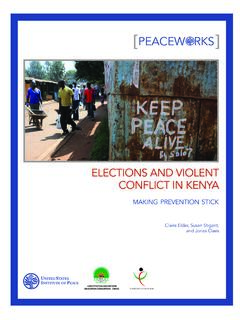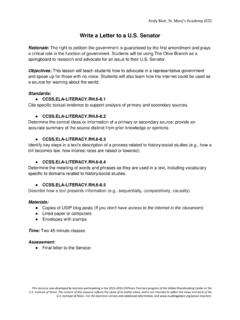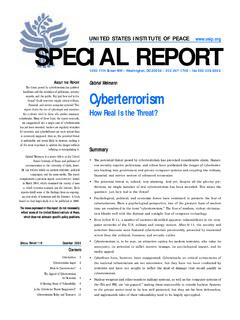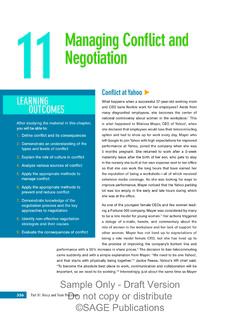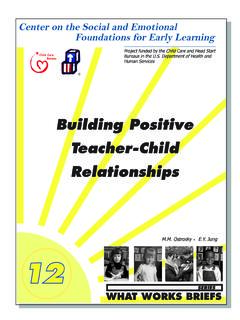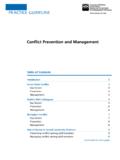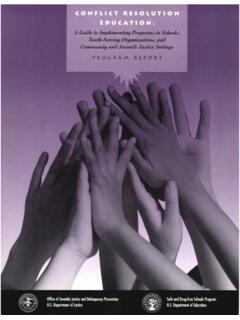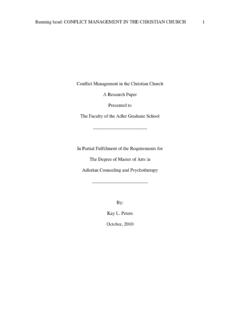Transcription of The Ukraine Russia Conflict - United States Institute of Peace
1 About the RepoRtAs the Ukraine crisis escalated, staff at the Institute of Peace (USIP) with experience in the region mobilized for a comprehensive Conflict analysis with the aim of identifying plausible Conflict scenarios and the forces and factors that propel them, ultimately pinpointing potential approaches that might prevent, mitigate, or resolve violent conflicts in the regions neighboring Russia . Using scenario analysis, facilitated by Alan Schwartz, Policy Futures, LLC, this report provides a framework for understanding emerging Conflict dynamics in post-Soviet countries and identifies Conflict prevention and mitigation the AuthoRsDr. Lauren Van Metre is a director in USIP s Center for Applied Research on Conflict , which conducts evidence-based research to improve practice in Conflict -affected countries. She holds a PhD in Russian Studies and has spent significant time working in St. Petersburg and conducting research throughout Russia s regions.
2 Viola Gienger is a senior writer for USIP, reporting and writing on issues related to the Institute s work in the United States and abroad. A career journalist, she previously covered foreign policy and national security for Bloomberg News and earlier spent seven years in Eastern Europe and the former Soviet Union training and consulting for independent media. Dr. Kathleen Kuehnast is director of the Center for Gender and Peacebuilding at USIP, which focuses on the gendered effects of Conflict and postconflict transition on both men and women. Her regional expertise is Central Asia, where she has written extensively on the impact of the post-Soviet transition on Muslim women. Garret Mitchell, an MA student at George Washington University, focusing his studies on Russia , contributed to this Constitution Ave., NW Washington, DC 20037 fax RepoRt 366 MAR ch 2015 2015 by the United States Institute of Peace . All rights Analysis 2 Ukraine : A Constant Boil 3 Nagorno-Karabakh: Overreach and Miscalculation 7 Kazakhstan: Cascading Instability 9 Conclusions and Recommendations 11 Lauren Van Metre, Viola G.
3 Gienger, and Kathleen KuehnastUNITED States Institute OF REPORTThe Ukraine - Russia ConflictSignals and Scenarios for the Broader RegionSummary Russia s annexation of Crimea and the military operations in eastern Ukraine have overturned the post Cold War norms that provided stability and development for the former Soviet now sovereign countries bordering Russia . Neighboring countries are recalculating their security and foreign policies through the lens of Ukraine , assessing their own security and Conflict dynamics based on Russia s newly aggres-sive policies and practices in Ukraine and the West s response. To understand these newly emerging trends and dynamics, the Institute of Peace (USIP)led a scenario analysis, taking a medium-term, regional outlook to identify the forces and factors propelling the potential for further Conflict . This analysis yielded a set of compelling narratives that provide a useful structure for understanding emerging Conflict dynamics in this region.
4 Ukraine has become a signal case, with the Conflict there leading to reactions throughout the countries on Russia s border. Countries in the region are actively testing the new contours of Russian and Western engage-ment, regional alliances and relationships, and regional Conflict dynamics. In the context of the regions frozen conflicts , these stress tests are risky and could ignite further violence. The Georgia- Russia war in 2008 and the annexation of Crimea are emblematic conflicts and demonstrate a strategic pattern to Putin s interventions. This archetypal constellation of fac-tors a destabilizing Conflict that halts democratic consolidation, the presence of an ethnic Russian population to justify intervention, strategic geopolitical location has implications for other vulnerable areas along the periphery, such as Transdniester and western Ukraine crisis escalated in early 2014 with the annexation of Crimea and the occupation of key government buildings in the country s east by pro-Russian separatists.
5 This fits into 2 SPECIAL REPORT 366a larger trend. From support for separatists in Moldova to the now seemingly emblematic war in Georgia, President Vladimir Putin s tactics regarding the sovereign nations of the former Soviet Union appear to reflect a larger pattern of destabilization begun more than a decade ago. With Ukraine now in the throes of violent Conflict , its effects are reverberat-ing across the globe. This raises the question of where Ukraine and other stressed areas in former Soviet republics may be headed and what an international community interested in stabilizing the situation may be able to do about it. Two USIP workshops held during the summer of 2014 sought to outline potential drivers of Conflict , sketch plausible scenarios that could lead to violent Conflict on a major scale, and pinpoint opportunities for peacebuilding. The USIP Conflict analysis team then scruti-nized each scenario with a range of specialists and stakeholders, including many regional civil society activists and American and European experts.
6 This scrutiny resulted in some changes to the scenarios but, at the same time, broadly reinforced the identified drivers of Conflict and underlined the urgency of comprehending and addressing the full scope of the potential for violent Conflict across the region and AnalysisScenario analysis is an analytical approach for describing possible futures in situations of high uncertainty and complexity that make accurate forecasts impossible. Such an analysis seeks to establish plausible outcomes by first identifying trends and dynamics that will interact to drive future events, in this case, in the next three to five in June 2014 identified multiple drivers contributing to Conflict in Russia s neighboring regions. Grouped into larger categories, these coalesced into four critical drivers. First is the extent of instability, whether indigenous or externally provoked. Some places might invite intervention because they are already unstable or on the precipice of Conflict ; Russia may also simply consider them valuable or important enough to intervene.
7 A succes-sion crisis following the death of a longtime autocratic leader (as is possible in Kazakhstan or Uzbekistan), an increasingly authoritarian regime that manipulates Conflict dynamics and suppresses dissent to consolidate power (as appears likely in Azerbaijan), or a large ethnic Russian population with real or imagined grievances (as is true in Ukraine ) could all foment second driver is Russia s own regime stability and internal support for Putin. The Krem-lin itself could drive or impede Russia s motivation and capacity to intervene in a Conflict . Presumably, Putin s ability or desire to intervene would be based in his comfort that Russia s key constituencies support an intervention. Weakness in his leadership might compel an intervention that would stoke Russian nationalist sentiment and support for the Western response to Russian action and how it is perceived regionally is a third driver.
8 A weak Western response to potential Conflict might embolden Russian adventurism. A weak response to Conflict also might make peacebuilding more , Putin s goals and objectives are a key driver. Whether Conflict occurs or grows, and how and where it might develop, in part depends on what Putin is seeking to achieve. The range of possible goals includes, but is not limited to, changing national borders, creat-ing frozen conflicts to weaken one or more countries, protecting crucial natural resources, extending spheres of influence for trade and political purposes, increasing Russia s interna-tional stature, deterring Western involvement in countries important to Russia , and hinder-ing the success of the Maidan model in Ukraine so that it has no attraction for the Russian populace and countries that Moscow seeks to retain in its sphere of influence. The views expressed in this report do not necessarily reflect the views of the United States Institute of Peace , which does not advocate specific policy request permission to photocopy or reprint materials, e-mail: the instituteThe United States Institute of Peace is an independent, nonpartisan institution established and funded by Congress.
9 Its goals are to help prevent and resolve violent conflicts , promote postconflict peacebuilding, and increase Conflict management tools, capacity, and intellectual capital worldwide. The Institute does this by empowering others with knowledge, skills, and resources, as well as by its direct involvement in Conflict zones around the d of diRectoRsStephen J. Hadley, (Chair), Principal, RiceHadleyGates, LLC, Washington, DC George E. Moose (Vice Chair), Adjunct Professor of Practice, The George Washington University, Wash-ington, DC Judy Ansley, Former Assistant to the President and Deputy National Security Advisor under George W. Bush, Wash-ington, DC Eric Edelman, Hertog Distinguished Practitioner in Residence, Johns Hopkins School of Advanced International Studies, Washington, DC Joseph Eldridge, University Chaplain and Senior Adjunct Professorial Lecturer, School of International Service, American University, Washington, DC Kerry Kennedy, President, Robert F.
10 Kennedy Center for Justice and Human Rights, Washington, DC Ikram U. Khan, President, Quality Care Consultants, LLC., Las Vegas, NV Stephen D. Krasner, Graham H. Stuart Professor of International Relations at Stanford University, Palo Alto, CA John A. Lancaster, Former Executive Director, International Council on Independent Living, Potsdam, NY Jeremy A. Rabkin, Professor of Law, George Mason University, Fairfax, VA J. Robinson West, Chairman, PFC Energy, Washington, DC Nancy Zirkin, Executive Vice President, Leadership Conference on Civil and Human Rights, Washington, DC MeMbers ex OfficiOJohn Kerry, Secretary of State Ashton Carter, Secretary of Defense Gregg F. Martin, Major General, Army; President, National Defense University Nancy Lindborg, President, United States Institute of Peace (nonvoting) SPECIAL REPORT 366 3In applying these drivers to the situation in the broader region, and thinking about how they might interact in the next three to five years, several Conflict scenarios emerged in a July 2014 session.


